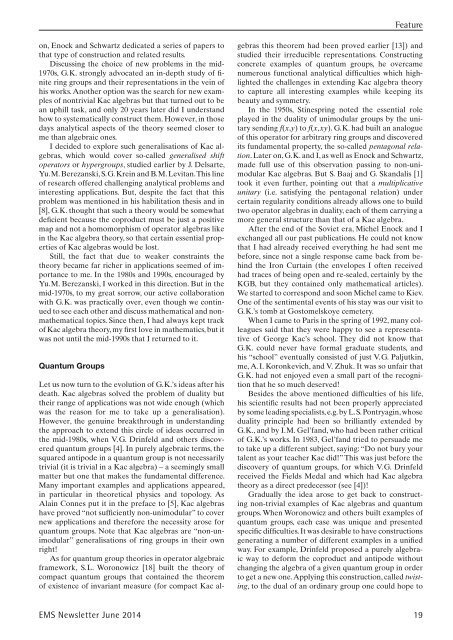1mZ2hsN
1mZ2hsN
1mZ2hsN
Create successful ePaper yourself
Turn your PDF publications into a flip-book with our unique Google optimized e-Paper software.
Featureon, Enock and Schwartz dedicated a series of papers tothat type of construction and related results.Discussing the choice of new problems in the mid-1970s, G. K. strongly advocated an in-depth study of finitering groups and their representations in the vein ofhis works. Another option was the search for new examplesof nontrivial Kac algebras but that turned out to bean uphill task, and only 20 years later did I understandhow to systematically construct them. However, in thosedays analytical aspects of the theory seemed closer tome than algebraic ones.I decided to explore such generalisations of Kac algebras,which would cover so-called generalised shiftoperators or hypergroups, studied earlier by J. Delsarte,Yu. M. Berezanski, S. G. Krein and B. M. Levitan. This lineof research offered challenging analytical problems andinteresting applications. But, despite the fact that thisproblem was mentioned in his habilitation thesis and in[8], G. K. thought that such a theory would be somewhatdeficient because the coproduct must be just a positivemap and not a homomorphism of operator algebras likein the Kac algebra theory, so that certain essential propertiesof Kac algebras would be lost.Still, the fact that due to weaker constraints thetheory became far richer in applications seemed of importanceto me. In the 1980s and 1990s, encouraged byYu. M. Berezanski, I worked in this direction. But in themid-1970s, to my great sorrow, our active collaborationwith G. K. was practically over, even though we continuedto see each other and discuss mathematical and nonmathematicaltopics. Since then, I had always kept trackof Kac algebra theory, my first love in mathematics, but itwas not until the mid-1990s that I returned to it.Quantum GroupsLet us now turn to the evolution of G. K.’s ideas after hisdeath. Kac algebras solved the problem of duality buttheir range of applications was not wide enough (whichwas the reason for me to take up a generalisation).However, the genuine breakthrough in understandingthe approach to extend this circle of ideas occurred inthe mid-1980s, when V. G. Drinfeld and others discoveredquantum groups [4]. In purely algebraic terms, thesquared antipode in a quantum group is not necessarilytrivial (it is trivial in a Kac algebra) – a seemingly smallmatter but one that makes the fundamental difference.Many important examples and applications appeared,in particular in theoretical physics and topology. AsAlain Connes put it in the preface to [5], Kac algebrashave proved “not sufficiently non-unimodular” to covernew applications and therefore the necessity arose forquantum groups. Note that Kac algebras are “non-unimodular”generalisations of ring groups in their ownright!As for quantum group theories in operator algebraicframework, S. L. Woronowicz [18] built the theory ofcompact quantum groups that contained the theoremof existence of invariant measure (for compact Kac algebrasthis theorem had been proved earlier [13]) andstudied their irreducible representations. Constructingconcrete examples of quantum groups, he overcamenumerous functional analytical difficulties which highlightedthe challenges in extending Kac algebra theoryto capture all interesting examples while keeping itsbeauty and symmetry.In the 1950s, Stinespring noted the essential roleplayed in the duality of unimodular groups by the unitarysending f(x,y) to f(x, xy). G. K. had built an analogueof this operator for arbitrary ring groups and discoveredits fundamental property, the so-called pentagonal relation.Later on, G. K. and I, as well as Enock and Schwartz,made full use of this observation passing to non-unimodularKac algebras. But S. Baaj and G. Skandalis [1]took it even further, pointing out that a multiplicativeunitary (i.e. satisfying the pentagonal relation) undercertain regularity conditions already allows one to buildtwo operator algebras in duality, each of them carrying amore general structure than that of a Kac algebra.After the end of the Soviet era, Michel Enock and Iexchanged all our past publications. He could not knowthat I had already received everything he had sent mebefore, since not a single response came back from behindthe Iron Curtain (the envelopes I often receivedhad traces of being open and re-sealed, certainly by theKGB, but they contained only mathematical articles).We started to correspond and soon Michel came to Kiev.One of the sentimental events of his stay was our visit toG. K.’s tomb at Gostomelskoye cemetery.When I came to Paris in the spring of 1992, many colleaguessaid that they were happy to see a representativeof George Kac’s school. They did not know thatG. K. could never have formal graduate students, andhis “school” eventually consisted of just V. G. Paljutkin,me, A. I. Koronkevich, and V. Zhuk. It was so unfair thatG. K. had not enjoyed even a small part of the recognitionthat he so much deserved!Besides the above mentioned difficulties of his life,his scientific results had not been properly appreciatedby some leading specialists, e.g. by L. S. Pontryagin, whoseduality principle had been so brilliantly extended byG. K., and by I. M. Gel’fand, who had been rather criticalof G. K.’s works. In 1983, Gel’fand tried to persuade meto take up a different subject, saying: “Do not bury yourtalent as your teacher Kac did!” This was just before thediscovery of quantum groups, for which V. G. Drinfeldreceived the Fields Medal and which had Kac algebratheory as a direct predecessor (see [4])!Gradually the idea arose to get back to constructingnon-trivial examples of Kac algebras and quantumgroups. When Woronowicz and others built examples ofquantum groups, each case was unique and presentedspecific difficulties. It was desirable to have constructionsgenerating a number of different examples in a unifiedway. For example, Drinfeld proposed a purely algebraicway to deform the coproduct and antipode withoutchanging the algebra of a given quantum group in orderto get a new one. Applying this construction, called twisting,to the dual of an ordinary group one could hope toEMS Newsletter June 2014 19


